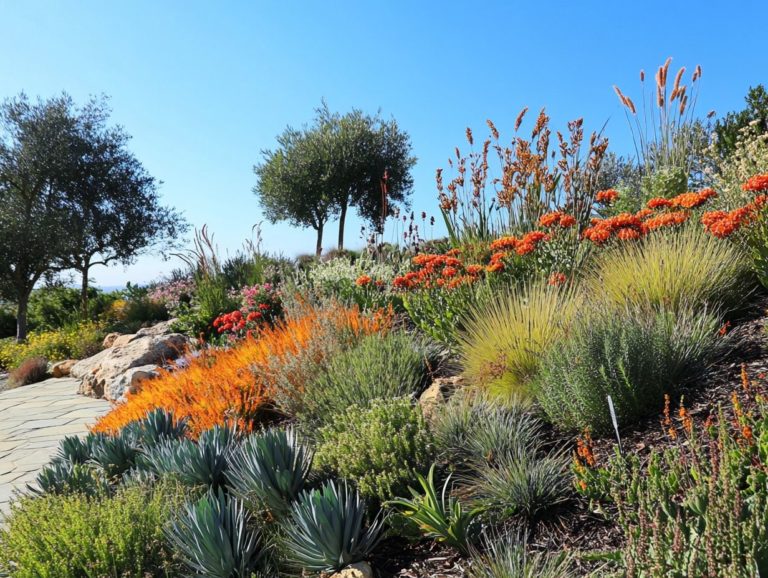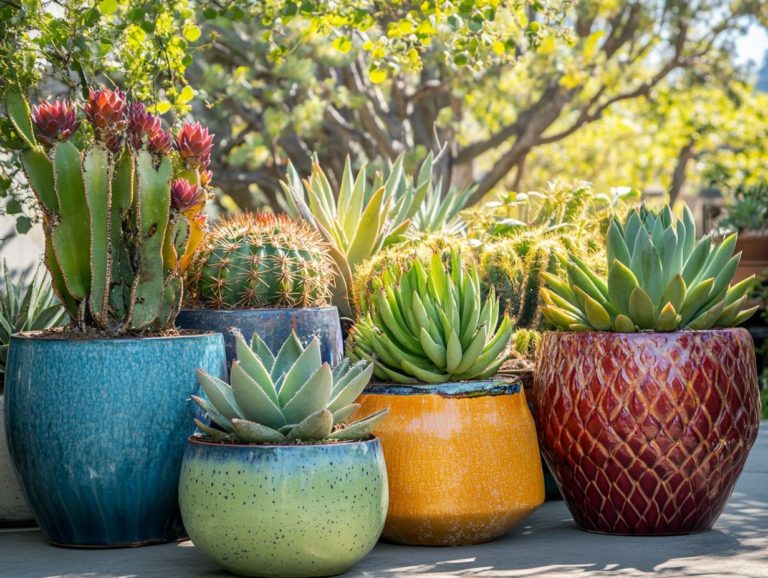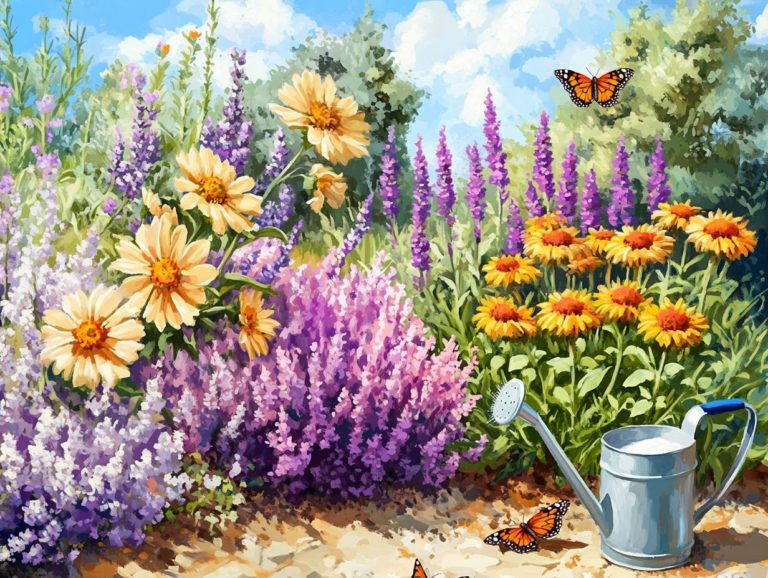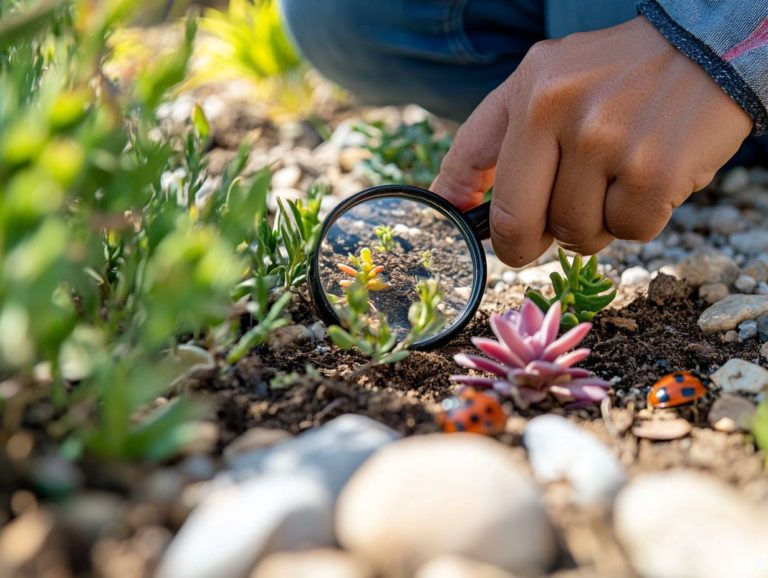Can I Combine Drought-Resistant and Traditional Plants?
Combining drought-resistant and traditional plants gives you a fantastic chance to create a vibrant garden that thrives in various conditions. This approach saves water and increases biodiversity, making your outdoor space more resilient.
Explore the benefits of this mix while considering your local climate and soil conditions. Discover effective planting strategies, maintenance tips, and pitfalls to avoid!
Get ready to transform your garden into a thriving ecosystem!
Contents
- Key Takeaways:
- The Benefits of Combining Drought-Resistant and Traditional Plants
- Factors to Consider Before Combining Plants
- How to Successfully Combine Drought-Resistant and Traditional Plants
- Maintaining a Mixed Garden
- Common Mistakes to Avoid
- Frequently Asked Questions
- Can I combine drought-resistant and traditional plants?
- What are the benefits of combining drought-resistant and traditional plants?
- Do drought-resistant and traditional plants require different care?
- Can I combine drought-resistant and traditional plants in containers?
- What are some examples of drought-resistant and traditional plant combinations?
- How can I ensure that my combination of plants will thrive?
Key Takeaways:
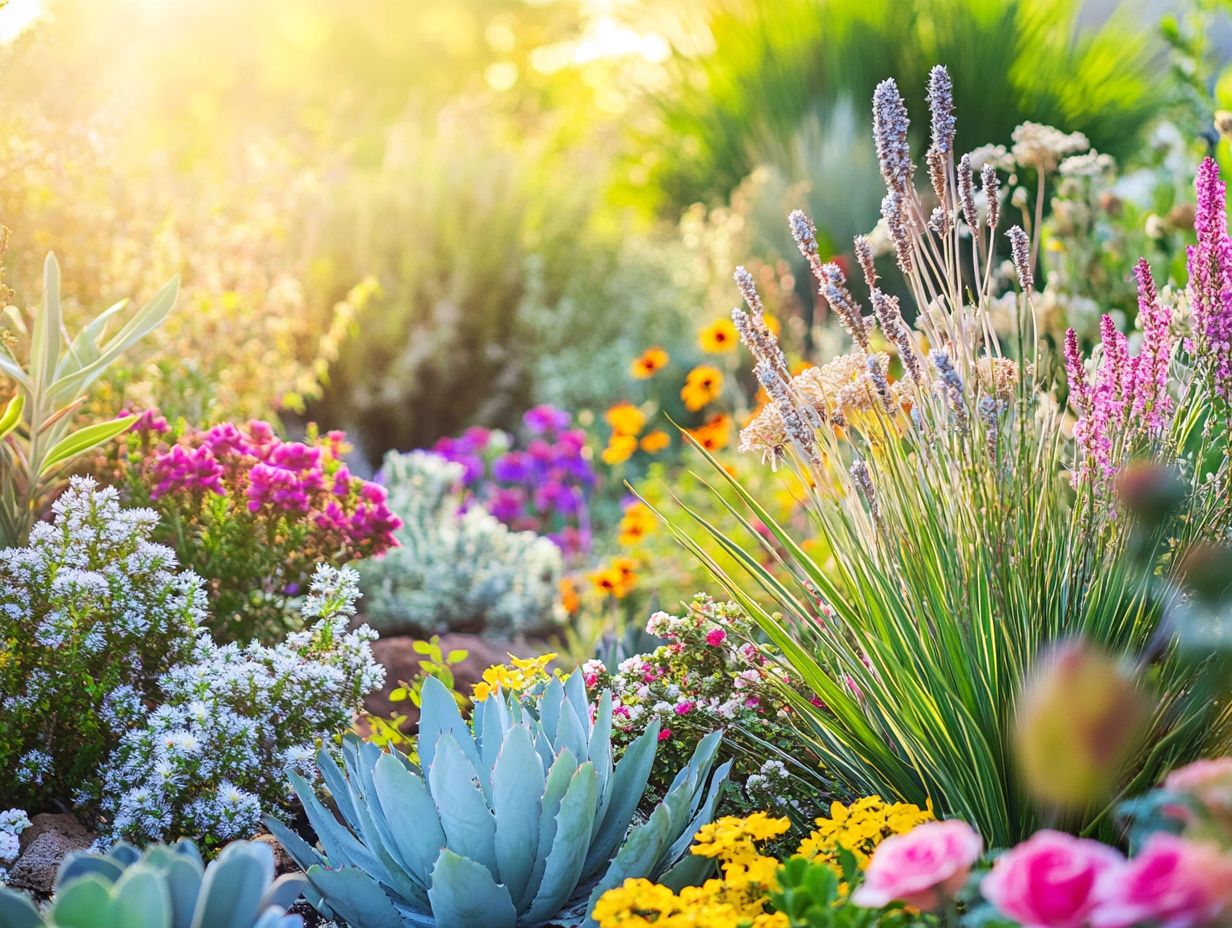
- Combining drought-resistant and traditional plants creates a balanced garden.
- Consider climate and soil conditions before you start.
- Use proper design and maintenance strategies for success.
The Benefits of Combining Drought-Resistant and Traditional Plants
This combination benefits Spokane homeowners looking for sustainable landscaping. It not only saves water but also enhances the beauty of your outdoor space.
Adding native plants with deep roots reduces water usage and simplifies maintenance during dry spells. This method supports a diverse ecosystem that helps local wildlife and minimizes the need for chemical fertilizers and pesticides.
Creating a Balanced and Sustainable Garden
To create a balanced garden, plan thoughtfully. Pair drought-tolerant native plants with traditional varieties that share care needs, following guidelines on how to design a drought-resistant landscape.
Focus your plant selection on local climate and soil. This boosts biodiversity and reduces resource dependency. Efficient irrigation practices, like drip systems, can help each plant thrive with minimal waste.
Using mulch effectively retains moisture and suppresses weeds, fostering a healthier garden. Adding organic matter like compost enriches the soil, promoting strong plant growth.
These strategies not only benefit individual plants but also improve air quality and create habitats for beneficial insects.
Factors to Consider Before Combining Plants
Before blending drought-resistant and traditional plants, consider several key factors.
Look at local climate, soil types, and plant compatibility. These elements are crucial for a thriving garden ecosystem.
Climate and Soil Conditions
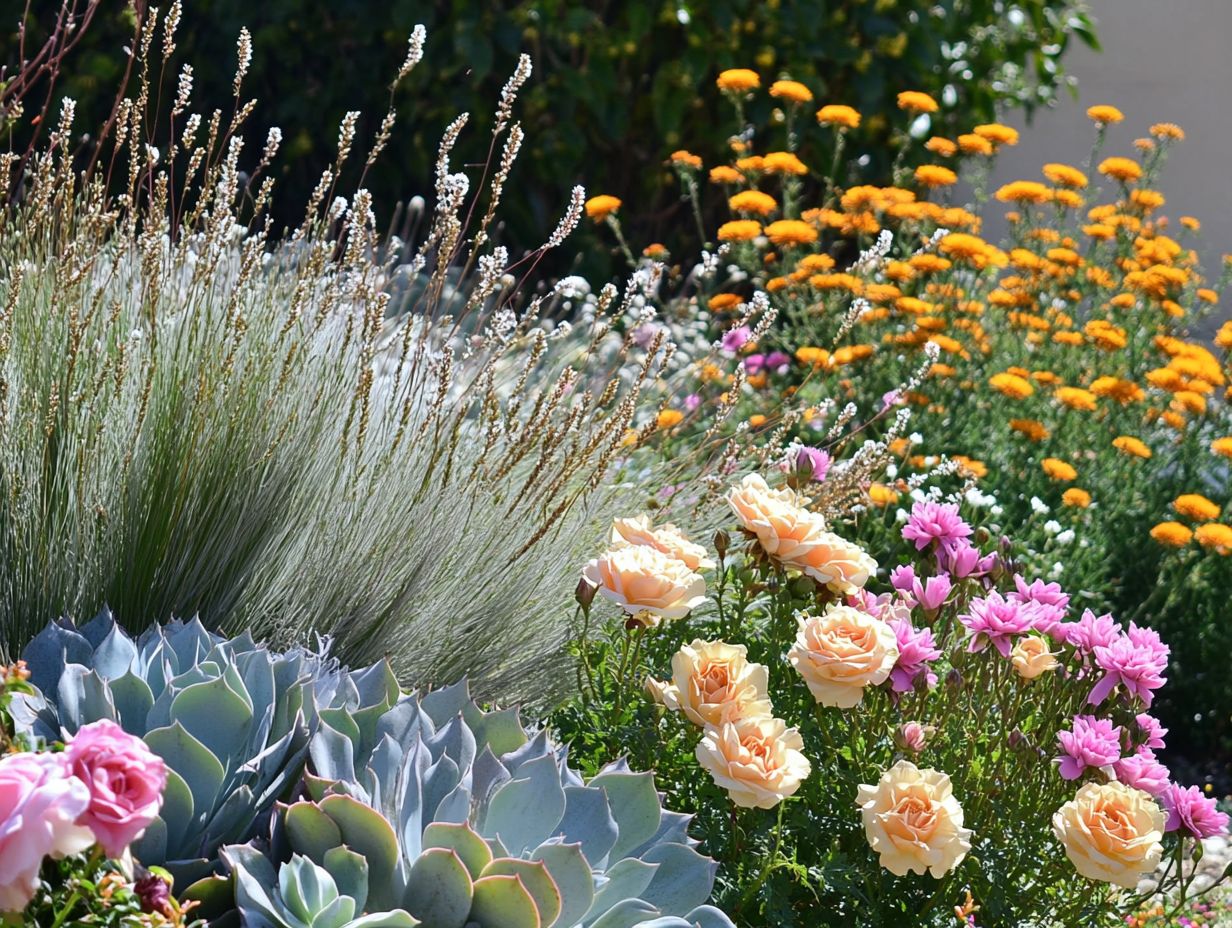
Understanding Spokane s climate and soil is crucial for selecting compatible plants and managing water usage. The area’s hot summers and cold winters affect your choices.
Spokane s seasonal rains can lead to overly moist or dry soil at different times. Knowing the drainage capacity and moisture levels is vital for preventing root rot.
This knowledge helps you select drought-resistant species and shapes your irrigation practices, ensuring optimal soil health while managing water effectively.
Compatibility of Plants
The compatibility of plant varieties is crucial for a thriving garden. By choosing certain native plants with deep root systems, you can significantly enhance the overall health and sustainability of your landscape.
As you select your garden companions, it s essential to consider factors like root systems, water needs, and growth habits. For example, pairing shallow-rooted species like lettuce with deeper-rooted varieties such as carrots allows for efficient use of soil nutrients and moisture.
Plants that share similar water requirements, like lavender and rosemary, thrive beautifully together, reducing the likelihood of overwatering or drought stress. In contrast, tall sunflowers can offer shade to low-growing herbs, creating a nurturing environment where all plants flourish in harmony.
These thoughtful combinations not only promote biodiversity but also cultivate a balanced ecosystem, ultimately making your garden more resilient and vibrant.
How to Successfully Combine Drought-Resistant and Traditional Plants
Blending drought-resistant and traditional plants requires careful planning and strategic planting. This approach allows you to create a harmonious landscape that satisfies your aesthetic preferences while effectively addressing practical water management goals. For more insights on this, check out how to use companion planting in drought gardening, particularly for homeowners in Spokane.
Designing and Planting Strategies
Great design and planting strategies are key for a successful garden. They help drought-resistant and traditional plants grow well with less maintenance.
By utilizing design techniques like layering, you can enhance both the visual interest and functionality of your garden. Proper spacing is equally important, allowing your plants to thrive without competing for resources. Choosing complementary colors and textures enriches the aesthetic appeal and fosters harmony throughout your landscape.
Incorporating organic mulch around your plants plays a vital role in moisture retention and weed control. This reduces the need for frequent watering and prevents unwanted growth that could detract from your garden s beauty. By balancing these elements, you can create a flourishing ecosystem that promotes biodiversity and sustainability.
Maintaining a Mixed Garden
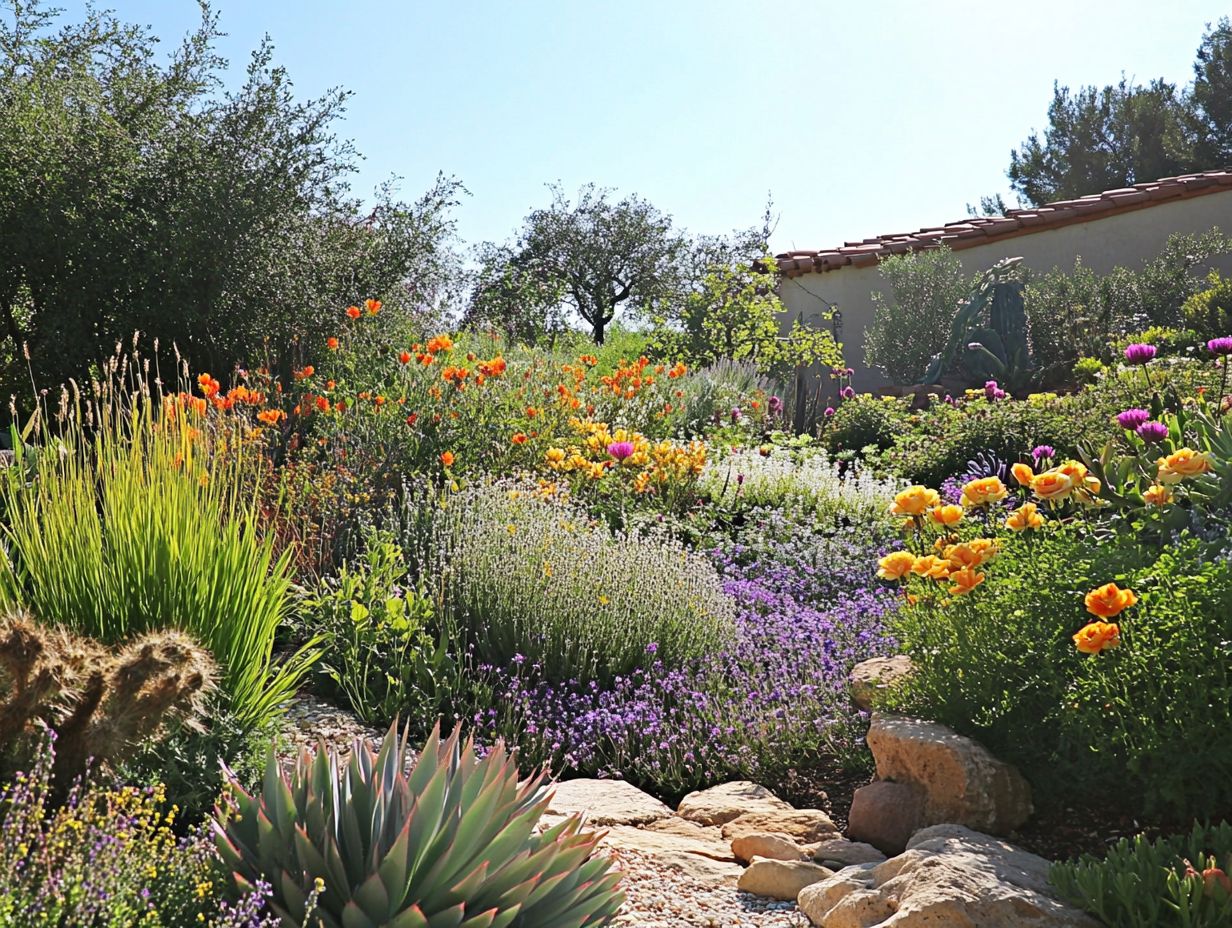
To create a thriving mixed garden, you need to master proper watering techniques, care routines, and an effective irrigation schedule.
Tailor these practices to meet the specific needs of your chosen plant varieties for optimal growth and harmony.
Proper Watering and Care Techniques
Implementing proper watering and care techniques is essential for the success of your mixed garden, ensuring that both drought-resistant and traditional plants receive the right amount of moisture without waste. To achieve this, learn how to plan a drought-resistant garden layout.
To achieve optimal hydration, explore various techniques, such as drip irrigation systems that deliver water directly to the plant roots, minimizing evaporation and runoff. Utilizing irrigation timers allows you to exercise precise control over watering schedules, making it easier to maintain consistency, especially during peak growth periods.
These systems also need backflow prevention to protect your water supply from contamination. Monitoring soil moisture levels ensures that your garden thrives while avoiding overwatering, which can lead to root rot and other diseases.
By combining these techniques, you can cultivate a healthier and more vibrant garden environment.
Common Mistakes to Avoid
Blending drought-resistant and traditional plants requires awareness of common mistakes and potential pitfalls that could undermine the success of your garden. Understanding why to choose drought-resistant plants will help you avoid these mistakes, enhancing plant health and optimizing water usage to meet their specific needs effectively.
Potential Pitfalls and How to Avoid Them
Understanding the potential pitfalls of combining drought-resistant and traditional plants allows you to sidestep common mistakes and explore creative ways to utilize drought-resistant plants that can positively affect plant health and the overall environment.
Not watering properly is a frequent misstep that can lead to the dilemma of under or over-watering. Both conditions put stress on your plants and stunt their growth. It is crucial to assess the specific water needs of both drought-resistant and traditional varieties, crafting a tailored watering schedule that meets those demands without excess.
Overlooking the environmental impacts of your plant choices can disrupt local ecosystems. Opting for native species, which are plants that naturally grow in your local area, is a step toward promoting sustainability. A well-planned garden simplifies maintenance and ensures that every plant flourishes, contributing to a healthier ecosystem while preserving visual appeal.
Frequently Asked Questions
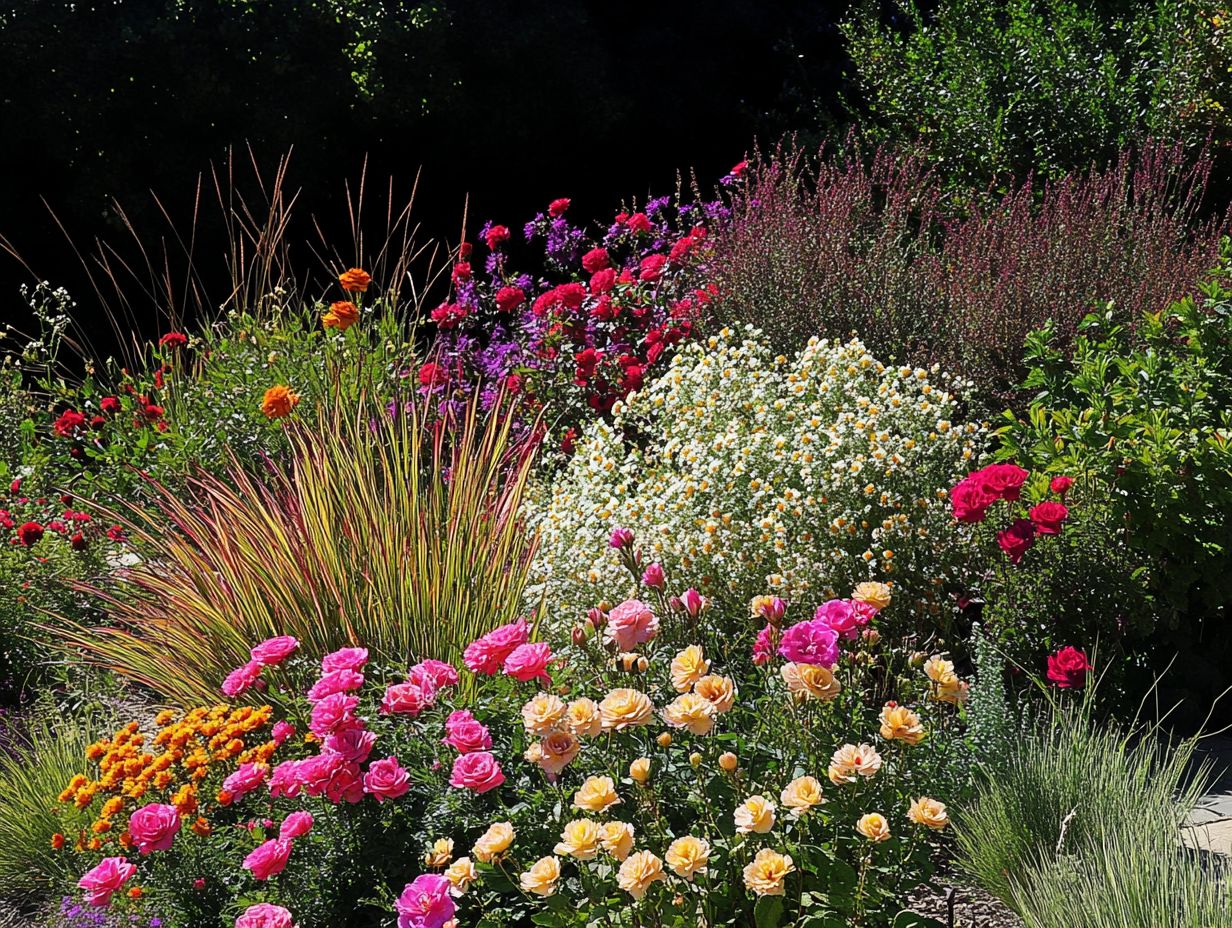
-
Can I combine drought-resistant and traditional plants?
-
Yes, you can combine drought-resistant and traditional plants in your garden or landscaping. This can be a great way to create a visually appealing and diverse landscape while also conserving water. For more information, check out if native plants can be used for drought resistance.
-
What are the benefits of combining drought-resistant and traditional plants?
-
Combining these types of plants allows for a more sustainable and efficient use of water, as drought-resistant plants require less water. You can also create a beautiful and dynamic landscape by incorporating a variety of plant species.
-
Do drought-resistant and traditional plants require different care?
-
Yes, these types of plants have different watering needs and may require different types of soil and fertilization. It is important to research and understand the specific care requirements of each plant before combining them.
-
Can I combine drought-resistant and traditional plants in containers?
-
Yes, you can combine these plants in containers. Just make sure to choose a container and soil that can accommodate the different needs of each plant, such as good drainage for drought-resistant plants and nutrient-rich soil for traditional plants.
-
What are some examples of drought-resistant and traditional plant combinations?
-
Some examples include pairing drought-resistant succulents with traditional flowering plants or mixing drought-resistant grasses with traditional shrubs. To learn more about effective techniques, you can explore what companion planting is for drought-resistant gardening. You can also create a themed garden by combining plants from the same region or climate.
-
How can I ensure that my combination of plants will thrive?
-
To ensure that your plants thrive, it is important to research and choose plants with similar light, soil, and water requirements. Regularly monitor and adjust watering schedules as needed for each plant. Consulting with a local gardening expert can also be helpful in creating a successful combination of plants.
This is your chance to create a stunning garden! Start planning now or consult local experts for tailored advice.


